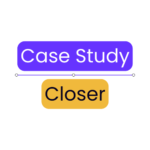Process
A reliable, repeatable system that creates impactful case studies fast
(1) Align
I’ll gather Marketing, Sales, and Customer Success insights from your team so that I can develop two foundational assets.
The first is a One-Page Case Study Strategy, which we’ll use to direct every future step.
The second is a Case Study Candidate Pipeline, which we’ll use to rank and prioritize customers according to your strategic criteria.
Timeline
Week 1
Milestones
Clarify your business goals
Define your case study criteria
Create candidate tracking system
Assets
One-Page Case Study Strategy
Case Study Candidate Pipeline
(2) Recruit
Once we identify a case study opportunity, I’ll help you craft an invitation that addresses common objections and makes it easy for your customer to say “yes.”
Assuming both sides are excited to move forward, you and your customer will sign a Case Study Release Form.
This document proactively confirms their commitment to the project and your plan for story promotion.
Timeline
Week 1 – 2
Milestones
Confirm case study opportunity
Personalize customer outreach
Secure formal commitment
Assets
Customer Outreach Scripts
FAQ Sheet (for Customers)
Case Study Release Form
(3) Produce
You make the intro and I handle all the heavy lifting.
I’ll prepare (myself AND your customer) for the interview, host the meeting, and share the recording.
Then I’ll write the draft, manage the feedback, and steer the story through final approvals.
Plus, you’ll never have to wonder how I’m progressing or when to weigh in.
You’ll see it all in our shared project management portal.
Timeline
Week 2 – 4
Milestones
Schedule customer interview
Send interview prep materials
Conduct and record interview
Turn transcript into story draft
Incorporate creative feedback
Secure stakeholder approvals
Assets
Interview Prep Kit
Customer-Approved Story
Progress-Tracking Project Hub
(4) Promote
The first priority after securing final approval is giving your case study a digital home. (Ex. Stylized blog post or PDF)
The second is repurposing the long-form story into multiple short-form assets. (See my most frequently produced formats in the FAQ section below.)
The third is arming your team (and customer) with tips and tools to amplify promotion.
Then we’ll regroup to review performance and consider improvements 30 days after launch.
Timeline
Week 3 – 4
Milestones
Stage case study on website
Create short-form story assets
Share promo tips with customer
Share promo tips with employees
Notify customer ahead of launch
Launch marketing campaigns
Review initial performance
Assets
Long-Form Case Study
Short-Form Story Assets (x 3)
Marketing Cheat Sheets (x 2)
Frequently Asked Questions
“Are all these steps really necessary?”
You could try skipping steps. Most companies (of all sizes) do.
But each skipped step raises your risk of abandoned projects, delayed approvals, and lackluster results.
I’ve consciously designed my process to ensure strategic alignment, accelerate creative production, and maximize promotional impact. Anything I ask of your company or customers directly serves those goals.
“How will we keep track of everything?”
My project management system has two components.
The first is an online portal that serves as our project hub. You can access it anytime to track progress and view assets.
The second is a weekly email I send that summarizes progress from the past week, plans for the next week, and any inputs I need from your team.
“Is 30 days a realistic timeline?”
It is, for me.
I built my case study process in direct response to the many time traps I saw — and often personally stumbled into – while working as a startup employee.
I also have several operational advantages working in my favor.
Compared to my clients, I have more time to focus on fewer priorities.
Compared to most agencies, I have less bloat and stronger specialization.
Compared to most freelancers, I have more skill, experience, and perspective.
And because I:
- Pursue only qualified case study opportunities
- Document expectations before creative production begins
- Deliver story drafts to customers within 3 days of their interview
- Work through project milestones simultaneously, not sequentially
I’m able to confidently include time-based performance guarantees in my pricing terms.
“What if you don’t deliver in 30 days?”
Despite everything I do to limit this risk proactively, I can’t eliminate it entirely.
So I offer conditional, money-back guarantees instead.
(Note: I haven’t had to invoke those policies yet. But I want my clients to know I have a strong financial stake in the speed of their success.)
“Which long-form assets do you typically produce?”
If the primary goal is brand awareness: I’ll produce a blog post styled to your brand.
If the primary goal is lead capture: I’ll produce a PDF file and write the copy for its landing page.
In every case: I’ll work with a graphic designer from your team (or my network) to ensure the final product is visually appealing and high-converting.
“Which short-form assets do you typically produce?”
After finalizing the long-form story, I often repurpose case studies into:
- One-pagers
- Event brochures
- Presentation slides
- Social media posts
- Website testimonials
- Sales outreach emails
- Marketing nurture emails
But I’m also happy to hear new ideas or brainstorm more suggestions. After all, versatility is a big reason why case study content is so valuable.
In every case: I’ll work with a graphic designer from your team (or my network) to ensure the final product is visually appealing and high-converting.
“Do you produce video content?”
No, I currently do not.
I understand the appeal of video, but its tradeoffs include:
- Fewer customers willing to participate
- Less control over story messaging
- Longer production schedules
- Longer approval timelines
- Higher production costs
For these reasons, I believe written case studies are still the smartest place to start.
